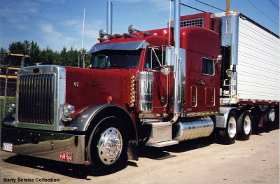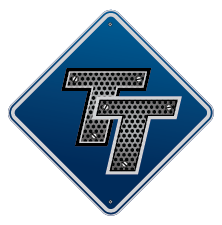Question About Double Clutching
Topic 14887 | Page 1
Scott, a big rig transmission has no synchronizers like a car's standard transmission - they simply don't hold up to the stress. Therefore to synchronize things and get the gears to mesh together everything in that transmission has to be spinning at the proper speed. When you disengage the clutch, things quickly slow down inside the gear box making it difficult to mesh the gears together (grinding). Double clutching re-engages the clutch bringing the rpm of the gears up to match the engine speed which makes shifting a lot smoother. That's a layman's explanation of how it works.
You can accomplish the same thing by floating the gears if you time your shift properly. The clutch stays engaged and things keep spinning at the right speed if done properly.
It's good to know how to double clutch , but 99% of the time experienced drivers never waste the effort of using the clutch.
All states require it on their driving test, and most drivers never do it again after that test.
Double Clutch:
To engage and then disengage the clutch twice for every gear change.
When double clutching you will push in the clutch, take the gearshift out of gear, release the clutch, press the clutch in again, shift the gearshift into the next gear, then release the clutch.
This is done on standard transmissions which do not have synchronizers in them, like those found in almost all Class A trucks.
Double Clutching:
To engage and then disengage the clutch twice for every gear change.
When double clutching you will push in the clutch, take the gearshift out of gear, release the clutch, press the clutch in again, shift the gearshift into the next gear, then release the clutch.
This is done on standard transmissions which do not have synchronizers in them, like those found in almost all Class A trucks.
Thanks OS. That answers it perfectly.

Why double clutch?
Because you have to for DMV to pass your skills test and get your CDL. 😄
Unless you test with an automatic and therefore will have an automatic only restriction on your license.
CDL:
Commercial Driver's License (CDL)
A CDL is required to drive any of the following vehicles:
- Any combination of vehicles with a gross combined weight rating (GCWR) of 26,001 or more pounds, providing the gross vehicle weight rating (GVWR) of the vehicle being towed is in excess of 10,000 pounds.
- Any single vehicle with a GVWR of 26,001 or more pounds, or any such vehicle towing another not in excess of 10,000 pounds.
- Any vehicle, regardless of size, designed to transport 16 or more persons, including the driver.
- Any vehicle required by federal regulations to be placarded while transporting hazardous materials.
Double Clutch:
To engage and then disengage the clutch twice for every gear change.
When double clutching you will push in the clutch, take the gearshift out of gear, release the clutch, press the clutch in again, shift the gearshift into the next gear, then release the clutch.
This is done on standard transmissions which do not have synchronizers in them, like those found in almost all Class A trucks.
Dm:
Dispatcher, Fleet Manager, Driver Manager
The primary person a driver communicates with at his/her company. A dispatcher can play many roles, depending on the company's structure. Dispatchers may assign freight, file requests for home time, relay messages between the driver and management, inform customer service of any delays, change appointment times, and report information to the load planners.DMV:
Department of Motor Vehicles, Bureau of Motor Vehicles
The state agency that handles everything related to your driver's licences, including testing, issuance, transfers, and revocation.
New Reply:
New! Check out our help videos for a better understanding of our forum features

















Preview:








 TT On Facebook
TT On Facebook
Why double clutch? Is it better for the transmission? Why not shift like a car with a manual transmission? Just curious. Asked a driver with 30 plus years of driving and he said just float them.
Double Clutch:
To engage and then disengage the clutch twice for every gear change.
When double clutching you will push in the clutch, take the gearshift out of gear, release the clutch, press the clutch in again, shift the gearshift into the next gear, then release the clutch.
This is done on standard transmissions which do not have synchronizers in them, like those found in almost all Class A trucks.